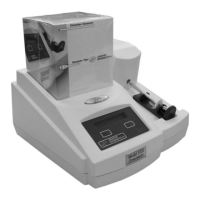2
Instrument Operation
In order to run your instrument properly, it is important that
you read and adhere to the instructions in this section. For
information on calibration, see Chapter 3 — Calibration.
Hazardous material cautions
• WARNING: Handle all biohazardous materials according to
established good laboratory practices and follow your institu-
tion’s exposure control plan. Persons handling blood and
body fluid samples must be trained in blood-borne hazards
and observe universal precautions. Universal precautions is
an approach to infection control, where all blood and body
fluids are treated as if known to be infectious. Use personal
protective equipment such as gloves, gowns, etc., to prevent
exposure. Store biohazardous materials in regulated waste
containers and dispose of these materials in a safe and
acceptable manner that is in compliance with all country,
state and local requirements.
• If a biohazardous material is spilled on or inside the equip-
ment, decontaminate the equipment using a 1% bleach solu-
tion, or as outlined by those policies and procedures estab-
lished within your institution.
• To avoid injury or fire hazard, do not operate this product in
an explosive atmosphere.
Function of major components
The major components of the Model 3320 Micro-Osmometer
are: a test sampler, an operating cradle, a cooling system with
7

